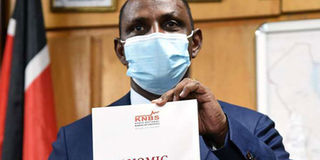Local debt grows with Sh106bn Bretton Woods loan

National Treasury Cabinet Secretary Ukur Yatani launches the Economic Survey 2020 at Treasury Building in Nairobi on April 28, 2020. PHOTO | FILE | NATION MEDIA GROUP
What you need to know:
- The borrowing spree has been supported by Parliament’s move to increase the country’s credit ceiling to Sh9 trillion.
- The bank noted that to secure the financing, Kenya has undertaken policy reforms that directly benefit many low-income Kenyan households.
- Treasury said the loan approval by the World Bank is a vote of confidence in the government’s handling of the economy.
Kenya has engaged the voracious borrowing gear that has characterised the Jubilee government’s reign once again, thanks to the Covid-19 pandemic.
The government has added at least Sh190 billion to its mountain of debt — which is inching towards dangerous territory — from the International Monetary Fund (IMF) and the World Bank in less than two months.
On Wednesday, the World Bank approved the latest loan of Sh106 billion ($1 billion) meant for budget support. This is the single biggest loan yet from the Bretton Woods institution to Kenya.
Given Kenya’s classification as a lower middle-income country, the loan comprises a Sh79.5 billion credit from the International Development Association (IDA) and Sh26.5 billion from the International Bank for Reconstruction and Development (IBRD).
The lender said the loan would help Kenya close the fiscal financing gap, which means it will be used to meet the government’s revenue shortfall.
Earlier this month, IMF gave Kenya Sh78.3 billion to help fight the Covid-19 pandemic. The money would be drawn under the Rapid Credit Facility.
In April, the World Bank gave the Health ministry Sh5.3 billion to finance production of sanitisers, protective gear for medical personnel and scaling up bed capacity for Covid-19 patients.
This adds to about Sh190 billion in under two months.
DEBT CEILING
If what the government has been borrowing locally and from other multilateral lenders is added, this figure grows to over Sh200 billion.
By March, Kenya’s total debt was more than Sh6.3 trillion; it is now fast racing towards the Sh7 trillion mark. Once it opens the doors wider to commercial debt, things will only get worse.
The borrowing spree has been supported by Parliament’s move to increase the country’s credit ceiling to Sh9 trillion.
Treasury, which is facing its biggest revenue shortfall in over a decade, said the loan approval by the World Bank is a vote of confidence in the government’s handling of the economy.
He added that the World Bank does not provide budget support to countries with a weak macro-economic framework.
Treasury Cabinet Secretary Ukur Yatani said the funds will be directed toward strengthening health systems, including providing better access to health services, improve disease surveillance, and public health interventions.
Mr Yatani said the Covid-19 pandemic has had an adverse impact on production in all sectors of the country’s economy.
Besides the health crisis, he said, the effects of the locust invasion and floods are expected to significantly slow down economic growth.
CREDIT RATING
In the 2020/21 budget, the national government expects to generate Sh1.8 trillion in revenue.
Budget experts have termed this too ambitious since it is almost the same amount as what it planned to raise in the current financial year. The revenue is against a total expenditure plan of Sh2.7 trillion.
This leaves the government with a deficit of Sh858.8 billion, the biggest in Kenya’s history. The government will, therefore, borrow a staggering Sh736 billion.
But this borrowing will become harder given that Kenya’s credit rating was last week downgraded from stable to negative due to the fast accumulation of debt.
The World Bank also stated that the latest loan will support reforms that help advance the government’s inclusive growth agenda, including affordable housing and support to farmers’ incomes.
“The Kenya Inclusive Growth and Fiscal Management Development Policy Financing (DPF) is the second of a two-operation programmatic series aimed at recreating fiscal buffers over the medium term and crowding in private investment,” the bank said in a statement.
POLICY REFORMS
It noted that the preparation of the loan started long before Covid-19 struck. However, its approval is timely, as it will help to fill the financing gap generated by the severe, ongoing shock to Kenya’s economy, the lender added.
“The DPF thus complements the recently approved Kenya Covid-19 Emergency Response Project, which seeks to prevent, detect and respond to the Covid-19 outbreak and strengthen national systems for public health emergency preparedness,” the bank added in a statement.
“This operation provides concessional resources to help Kenya navigate the current Covid-19 crisis and to cushion the impact on livelihoods and jobs, while supporting the continued operation of essential public services, said World Bank Country Director for Kenya Felipe Jaramillo.
The bank noted that to secure the financing, Kenya has undertaken policy reforms that directly benefit many low-income Kenyan households.
“Smallholder farmers will now benefit from better targeting of subsidised agricultural inputs through electronic vouchers. The supply of affordable housing is expected to increase, on the back of the updating of antiquated legislation that hindered the development of the housing market,” the lender noted.





